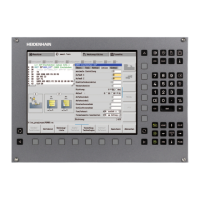January 2012 6.16 The Control Loop 939
When determining the optimum switching speed for the PWM frequency, you
should consider that the maximum motor current decreases as the speed
rises, due to the finite DC-link voltage.
The current for the drive depends on the maximum permissible motor current
and power-module current. The smaller of the two values limits the current for
the drive. The value of the maximum power-module current is reduced by
approx. 30 % because of the derating when doubling the PWM frequency.
The optimum switching speed results from the intersection of the maximum
current curve of the motor with the maximum current curve of the power
module for the high PWM frequency. You can determine the maximum
current curve of the spindle motor by using the TNCscopeNT software.
Record the current Inoml/S in dependency of the speed. The spindle must be
accelerated to the maximum speed so that the derating behavior can be seen
in the curve. The figure shows the behavior when the values entered for the
switching speed (MP_motSpeedSwitchOver and
MP_motSpeedSwitchBack) are too low. This then results in a speed range
where the current for the motor is less than the permitted and maximum
current, resulting in inconsistencies in the motor’s torque behavior.
• 1: Red line: Maximum current for the drive, resulting from the entries in
MP_motSpeedSwitchOver and MP_motSpeedSwitchBack.
• 1: Broken line:
Maximum possible current for the drive (Imax of motor)
• 2: Switching point for the PWM frequency set too low
• 3: Optimum switching point for the PWM frequency
• 4: Maximum power-module current at low PWM frequency
• 5: Maximum power-module current at high PWM frequency
(Imax of power module)

